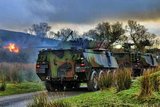BAE awarded DARPA contract for space machine learning
BAE Systems has been awarded a US Defense Advanced Research Projects Agency (DARPA) phase 2 contract to develop machine learning capabilities to help the US Department of Defense gain better awareness of space scenarios.
DARPA’s Hallmark Tools, Capabilities, and Evaluation Methodology (Hallmark-TCEM) programme is designed to develop and evaluate tools and capabilities that increase an operator's understanding of space events.
As space assets such as satellites become increasingly important and relied upon by the DoD for communications, surveillance, and security, Hallmark-TCEM will enhance an operator’s ability to select effective courses of action for any given situation.
For the programme, BAE Systems' FAST Labs research and development team will build cognitive-based machine learning algorithms and data models aimed at providing space operators with the ability to identify abnormal activities and predict possible threats.
The team will build on phase 1 of the programme, and continue to leverage its development of the Multi-INT Analytics for Pattern Learning and Exploitation (MAPLE) technology with a system called MAPLE Automates Joint Indications and Warnings for Cognitive Counter-Space (MAJICS).
‘Our technology builds data models based on normal activity and then ingests large amounts of real-time, streaming data to compare against the normal model and determine if any abnormal activity is occurring or will occur,’ John Hogan, product line director of the sensor processing and exploitation group at BAE Systems, said.
‘By using this technology, we hope to reduce the operator's workload by providing a solution that will automatically predict space events such as launches or satellite movements based on millions of pieces of data, helping them make rapid decisions to avoid any potential threats.’
BAE Systems' research on the Hallmark-TCEM programme adds to the company's machine learning and artificial intelligence segment of its autonomy technology portfolio.
The capabilities developed under the Hallmark-TCEM effort will be integrated into DARPA's Hallmark Software Testbed (Hallmark-ST) programme.
Work for the programme will be completed at the company's facilities in Burlington, Massachusetts and Reston, Virginia.
More from Digital Battlespace
-
![Babcock nears first customer for Nomad AI translation tool]()
Babcock nears first customer for Nomad AI translation tool
Nomad can provide militaries with real-time intelligence, saving critical time on the battlefield.
-
![AUSA 2025: Israel’s Asio Technologies to supply hundreds of improved Taurus tactical systems]()
AUSA 2025: Israel’s Asio Technologies to supply hundreds of improved Taurus tactical systems
Taurus operates alongside the Israel Defense Forces’ Orion system which supports mission management across tens of thousands of manoeuvring forces, from squad leaders to battalion commanders.
-
![AUSA 2025: Kopin pushes micro-LED plans as China moves faster]()
AUSA 2025: Kopin pushes micro-LED plans as China moves faster
The plan for the new displays follows fresh investment in Kopin’s European facilities by Theon and an order for head-up displays in fielded aircraft, with funding from the US Department of Defense.
-
![AUSA 2025: Persistent Systems to complete its largest order by year’s end]()
AUSA 2025: Persistent Systems to complete its largest order by year’s end
Persistent Systems received its largest ever single order for its MPU5 devices and other systems earlier this month and has already delivered the 50 units to the US Army’s 4th Infantry Division.
-
![Aselsan brings in dozens of companies and systems under the Steel Dome umbrella]()
Aselsan brings in dozens of companies and systems under the Steel Dome umbrella
Turkey has joined the family of countries attempting to establish a multilayered air defence system with government approval in August 2024 for the effort landed by Aselsan. Dubbed Steel Dome, the programme joins Israel’s Iron Dome, the US Golden Dome, India’s Mission Sudarshan Chakra and South Korea’s low-altitude missile defence system.
-
![DSEI 2025: MARSS unveils new agnostic multidomain C4 system]()
DSEI 2025: MARSS unveils new agnostic multidomain C4 system
MARSS’ NiDAR system has been deployed using sensors from static platforms to provide detection and protection for static sights, such as critical infrastructure, ports and military bases.




























